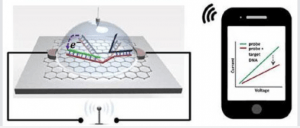As the gesture function gradually joins the user interface (UI) of products such as smartphones and tablets, the sensor market for tracking the movement of the hand with the touch screen is exploding.
There are two types of mobile phone-based gesture solutions on the market today – capacitive and infrared proximity. On devices that support gestures, dedicated proximity sensors detect motion in all directions, up, down, left, and right in a two- or three-dimensional manner. Current touch screen operations require direct touch with a finger or stylus, while capacitive gesture control goes one step further, allowing the user to interact with the device as soon as they are close to the screen.
One example:

A new Gesture Sensor Module from Alsrobot is based on APDS-9960 sensor which can recognize gesture direction from up, down, left and right. IC APDS-9960 integrate the fuction of RGB, ambient light, approach and guesture detector. Guesture sensor use I2C interface, by using accordingly Arduino fuction to realize PGM programme, feedback signal from gesture sensor module can be use as control signal to control the robot. With intelligent built-in recognition algorithm to free your hands. This item can work in contactless control scenarios, such like noncontact mouse,smart home,control of car pointing device and human-robot interaction etc.
price: $9.08
Specification:
- Input voltage:3.3V-5V
- PIN interface: IICx interrupt PIN x1
- Interface type: straight PIN, KF2510
- Size:30mm x 25mm
- Location hole: 4, separation distance 23mm x 18mm
- Detect distance: 100mm
- Weight: 3g
- PINs: -:GND /+:VCC/SDA:TxDn/SCL
- Compatible with infrared sensor module
Skill level required for electronics and coding: Expert




